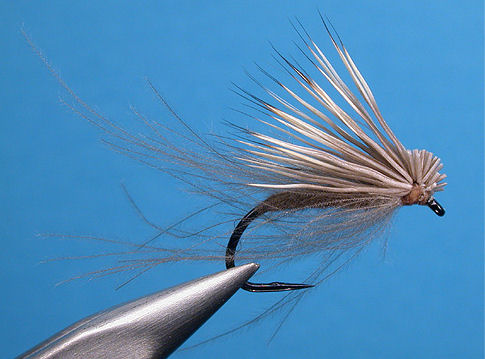
On The Fly
"Fly tying is a school from which we never graduate"
TYING NEWS
The Southern Oregon Fly Tyers invite you to attend their next meeting, Tuesday, June 8,
2010, at 6:30 PM, at the Madrone Hill Mobile Home Park community building near Gold Hill. Bring a
friend, come early so you don't miss anything, and stay late. Tiers need not be experienced, and those with
all levels of skill are welcome. Each meeting a member is encouraged to demonstrate a new or different
skill, from simple to difficult. For more information, call Dan Kellogg at 773-4724.
Our May Expo night had a great turnout and a very enjoyable evening, made possible by
these outstanding tyers:Dick Bonamarte – Stayner Ducktail.Bill Logan - Bill's Copper Jack.Mike Marchando –
Graciously volunteered to tie at the last minute.Dave Roberts - Tiny dry flies and Catskill dries.Jim
Ulm - Chironomids.
Our June meeting will be another special night at SOFT. Again, there won't be any
tie-along on this evening. June 8 will be a dubbing night with several tyers demonstrating blending and
dubbing techniques, not necessarily any finished fly. Move from one demo to the next whenever you feel
like it. Bring a guest, and a notepad.
DIRECTIONS: Take Gold Hill Exit #40, off of I-5 and go west, toward Jacksonville, 1.3
miles, until you reach the brick entrance way to the Madrone Hill Mobile Home Park on the right. You’ll
pass a golf course parking lot on Your left shortly after leaving the freeway. After you turn right into the
mobile home park, proceed to the community building which is located about 100 yards ahead on the left. The
address is 8401 Old Stage Rd. Please park your vehicle on the bare dirt in the parking lot to avoid the
wooden septic covers in the grass.
PATTERN OF THE MONTH - CDC & Elk

Hook: Daiichi 1100 or 1170, standard dry #12-18
Thread: Brown, 8-0.
Body/Hackle: CDC feather.
Rib: Copper wire.
Wing/Head: Fine tipped deer hair.
Tying Instructions
Step 1: Mash the barb and mount the hook in the vise. Start the tying thread two eye widths behind the
eye and wrap a thread base back to a point just above the barb.
Step 2: Select a CDC feather of the proper color and size, fibers 2 times the shank length, gather the
tip fibers together and tie it in by the tip just above the barb.
Step 3: Spiral the thread forward to just behind the eye. Grab the butt of the CDC feather and wind it
forward around the shank in touching turns. Stoke the free barbules backwards as you make each turn. Tie
off and secure with thread wraps. Trim the CDC butt.
Step 4: Select a small bunch of straight, fine tipped deer hair and even the tips in a stacker. Measure
the bunch so the tips just reach the outside bend of the hook, trim the butts square with the front of
the eye, and tie down the wing to the top of the shank with tight thread wraps.
Step 5: Form a small thread head in front of the stubs, whip finish, and cement.
The CDC &Elk was developed by Hans Weilenmann in 1992 as a modified Elk-hair caddis.
Since then it has become a firm favorite with a multitude of anglers across several continents. It combines
the proven silhouette and buoyancy of Al Troth’s famous pattern and the dubbed body look and straggling
filaments from sprawling insect legs or a trailing shuck. It has become a go-to fly for many mayfly
hatches, a general search pattern to cover hatchless periods, an emerger pattern, and a wet fly. It is a
pattern deceptive in its simplicity and versatility. Martha, this is an extremely effective 2-material, 2
minute-to-tie winner.
While originally designed to be a dry caddis imitation, it has proven to be much more
useful. Try it during mayfly hatches, an emerger in the film, or a straight wet. The CDC & Elk has proven
to cover the full spectrum of dry, damp and wet. Lee, you have to try this one.
TYING TIPS
Selecting the right CDC feather is the key to tying success on this one. Not only do the
barbs need to be the proper length but the stem must be long and flexible enough to complete the body and
hackle. Here is a simple little tip for firmly securing the deer hair wing. After the first 4 initial
thread wraps, take one additional wrap about halfway through the hair stubs and another in front of the
stubs. It keeps the wing on top and keeps it from pulling out. Any tier can produce dozens of these babies,
so tie some up, give them a test flight and let me know how you do
Tie One On,
Dan Kellogg (you can contact me at FLYGUY@EZNORTHWEST.COM)